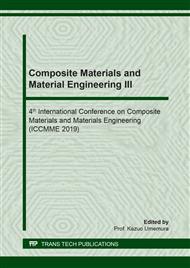[1]
Yang, J., and Jiang, G.: (2003). Cem. Concr. Res. Vol. 33(3) (2003), pp.381-386.
Google Scholar
[2]
Younger, Krey, R. G. Hicks, and Manfred Part l: Evaluation of porous pavements for road surfaces. (Department of Civil Engineering, Oregon State Univ., 1994).
Google Scholar
[3]
A. Hager, S. A. Durham and K. Rens, in: Sustainable design of pervious concrete pavement systems, Transportation Research Board 96th Annual Meeting, No. 17-01336 (2017).
Google Scholar
[4]
S. H. Kosmatka, B. Kerkhoff, and W. C. Panarese: Design and control of concrete mixtures. (14th Edition, Portland Cement Assoc., 2011).
Google Scholar
[5]
Malhotra, V. M.: J. Am. Concr. Inst. Vol. 73 (11) (1976), pp.628-644.
Google Scholar
[6]
P. D. Tennis, M. L. Leming, and D. J. Akers: Pervious Concrete Pavements. (Portland Cement Assoc., 2004).
Google Scholar
[7]
J. Prashanth, N. Harish, and D. P. Anup: Sustainable Materials and Management Systems in Civil Engineering, edited by Jagannadha Rao and Krishna Rao, Vrinda Publishing House, Hyderabad, India (2016).
Google Scholar
[8]
V. López-Carrasquillo and S. Hwang: Constr. Build. Mater. Vol. 139 (2017), pp.148-158.
Google Scholar
[9]
Y. J. Kim, A. Gaddafi, and I. Yoshitake: Mater. Des. Vol. 100 (2016), pp.110-119.
Google Scholar
[10]
J.J. Chang, W. Yeih, T.J. Chung and R. Huang: Constr. Build. Mater. Vol. 109 (2016), p.34–40.
Google Scholar
[11]
Z. Sun, X. Lin, and A. Vollpracht: Constr. Build. Mater. Vol. 189 (2018), pp.797-803.
Google Scholar
[12]
M. Frigione: Was. Mgmt., Vol. 30(6) (2010), pp.1101-1106.
Google Scholar
[13]
M. Yahya, B. Zhang, & M. Barker: Unpublished, (2014).
Google Scholar
[14]
M. Guendouz, F. Debieb, O. Boukendakdji, E. H. Kadri, M. Bentchikou, and H. Soualhi: J. Mater. Environ. Sci. Vol. 7, no. 2 (2016), pp.382-389.
Google Scholar
[15]
L. Akand, M. Yang, and X. Wang: Constr. Build. Mater. Vol. 163 (2018), pp.32-39.
Google Scholar
[16]
D. Foti: Compos. Struct. Vol. 96 (2013), pp.396-404.
Google Scholar
[17]
M. A. Jibrael, F. Peter: J Ecosys Ecograph Vol. 6(2) (2016).
Google Scholar
[18]
B. Rai, S. T. Rushad, B. Kr, and S. K. Duggal: ISRN Civil Engineering (2012).
Google Scholar
[19]
Indian Standard: 8112-43 Grade Ordinary Portland cement-Specification (First Revision. (Bureau of Indian Standards, New Delhi 1989).
Google Scholar
[20]
Indian Standard: 2386 (PART I-VIII) - Method of test for aggregate for concrete. (Bureau of Indian Standards, New Delhi 1963).
Google Scholar
[21]
ACI: 522R-10- Report on pervious concrete. (ACI Committee, 2010).
Google Scholar
[22]
A.Yahia and D. Kabagire: Constr. Build. Mater. Vol. 62 (2014), p.38–46.
Google Scholar
[23]
M. Sonebi, M. Bassuoni and A. Yahia: RILEM Technical Letters 1 (2016), p.109 – 115.
DOI: 10.21809/rilemtechlett.2016.24
Google Scholar
[24]
A. K. Chandrappa, and K. P. Biligori: Constr. Build. Mater. Vol. 123 (2016), p.627‐637.
Google Scholar
[25]
D. H. Nguyen, M. Boutouil, N. Sebaibi, L. Leleyter and F. Baraud: Constr. Build. Mater. Vol. 46 (2013), p.151‐160.
Google Scholar


